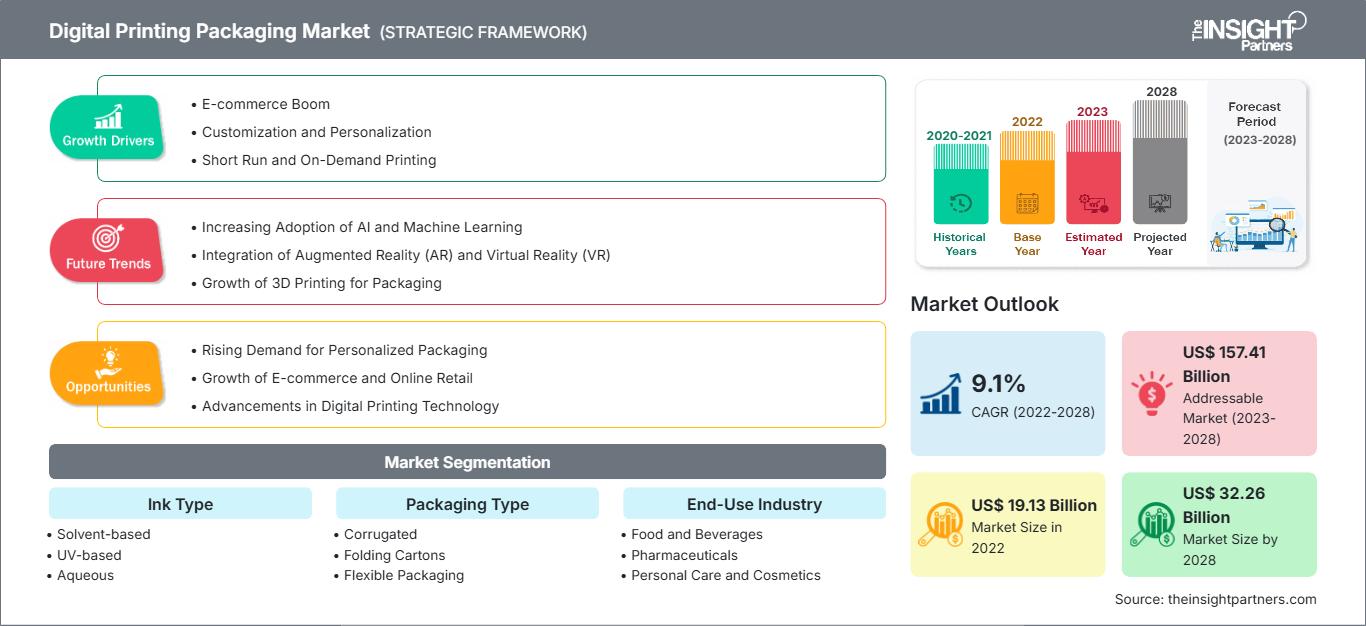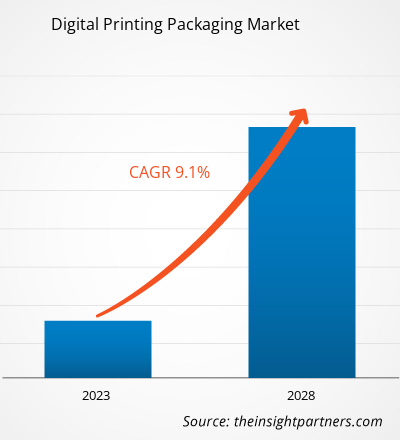デジタル印刷パッケージ市場規模は、2024年の224.7億米ドルから2031年には415.8億米ドルに達すると予測されています。市場は2025年から2031年の間に9.2%のCAGRを記録すると予想されています。
デジタル印刷パッケージ市場分析
デジタル印刷によるパッケージ市場は、パーソナライゼーションとパッケージ製品の迅速な配送に対する需要の高まりに伴い、ダイナミックに変化しています。ブランドはデジタル印刷技術を活用し、デザインとメッセージのパーソナライゼーションで消費者を惹きつけ、ブランドロイヤルティを構築しています。デジタル印刷は、食品、飲料、化粧品といった競争の激しい業界において、ブランドエクイティの向上に貢献しています。インクと印刷技術の進歩により、小ロット印刷やバリアブル印刷の効率的な生産が可能になり、eコマースや小売業界の進化する需要に対応しています。
デジタル印刷パッケージ市場の概要
デジタル印刷パッケージ市場は、企業が業務プロセスを合理化し、変化する消費者ニーズに迅速かつ多様に対応する方法を模索する中で、転換期を迎えています。リアルタイムのデザイン変更、インタラクティブなデザイン、そしてサプライチェーンへのよりスマートな統合は、フレキシブルフィルム、折りたたみカートン、段ボールケースといった新しいパッケージフォーマットに恩恵をもたらしています。
このレポートの一部、国レベルの分析、Excelデータパックなど、あらゆるレポートを無料でカスタマイズできます。また、スタートアップや大学向けのお得なオファーや割引もご利用いただけます。
デジタル印刷パッケージ市場:戦略的洞察

-
このレポートの主要な市場動向を入手してください。この無料サンプルには、市場動向から見積もりや予測に至るまでのデータ分析が含まれます。
デジタル印刷パッケージ市場の推進要因と機会
市場の推進要因:
- 印刷処理時間と在庫管理の負担を軽減:印刷サイクルを短縮することで、企業は短期間でパッケージング生産に対応できるようになります。また、在庫費用を削減し、無駄を最小限に抑えながらサプライチェーンの対応力を強化します。
- インパクトの強いグラフィック ビジュアル機能を使用したブランドの差別化: デジタル印刷により、ブランドは消費者の注目を集め、さまざまなカテゴリの製品の棚に忘れられない存在感を残す印象的なビジュアルとユニークなデザインを作成できます。
- パーソナライズされたカスタムバッチパッケージの需要の増加: カスタムおよび可変データパッケージを効果的に作成する機能は、個人へのキャンペーンに役立ち、マーケティングの関心と効果を高めます。
- 電子商取引の成長がニッチなパッケージングを促進: デジタル印刷による機敏でブランド化されたカスタマイズされた小包は、電子商取引ブランドによって、楽しい開封体験と追跡可能性を提供するために活用されており、オンライン小売市場で採用されています。
市場機会:
- フレキシブル パッケージ セグメントにおけるデジタル印刷の増加: 軽量で再封可能、視覚的にダイナミックな製品パッケージの需要が高まるにつれ、フレキシブル フィルムやポーチを使用して企業の多様化を図ることができます。
- インタラクティブ機能を備えたスマート パッケージの作成: 拡張現実、NFC、インタラクティブ コードをブランドに追加して、消費者と対話したり、製品情報やロイヤルティ プログラムを直接パッケージに表示したりすることもできます。
- 持続可能で循環的な経済のパッケージングイノベーション: バイオプラスチック、再利用可能なパッケージ、リサイクル可能性の研究は、ブランドが環境に優しいオプションとグリーンラベルに注目するにつれて、競争上の優位性をもたらします。
デジタル印刷パッケージ市場レポートのセグメンテーション分析
デジタル印刷パッケージ市場は、その仕組み、成長の可能性、そして最新のトレンドをより明確に把握するために、様々なセグメントに分割されています。以下は、ほとんどの業界レポートで使用されている標準的なセグメンテーション手法です。
インクの種類別:
- 溶剤ベース: 耐久性、汎用性、耐性に優れているため、さまざまな素材に強力で耐久性のあるプリントを求めるニーズに応えます。
- UV ベース: 即時硬化、豊かな色彩、低 VOC 排出量、高速、コスト効率に優れ、高品質のパッケージ印刷は、迅速な生産、持続可能性、優れたパッケージ標準に対する市場の需要によって推進されています。
- 水ベース: 持続可能なパッケージング、食品との安全な接触、規制順守による強力な採用、環境に優しく食品に安全な結果、鮮やかな結果。
- その他: 大豆インクとハイブリッドインクは、ニッチな用途やカスタム効果の分野で人気が高まっています。これは、環境と規制上の利点が重視されるようになったことが背景にあります。
梱包タイプ別:
- 段ボール包装
- 硬質包装
- フレキシブル包装
- ラベルとステッカー
-
その他
印刷技術別:
- インクジェット印刷
- 電子写真
- サーマルプリント
- その他
最終用途産業別:
-
食品・飲料
- 乳製品
- 飲み物
- 菓子
- その他
- 医薬品
- パーソナルケアと化粧品
- エレクトロニクス
- その他
地理別:
- 北米
- ヨーロッパ
- アジア太平洋
- 中東・アフリカ
- 南米と中央アメリカ
電子商取引と包装産業が急速に成長しており、アジア太平洋地域のデジタル印刷包装市場は強固な基盤を築いています。
デジタル印刷パッケージ市場の地域別分析
予測期間全体を通してデジタル印刷パッケージ市場に影響を与える地域的なトレンドと要因は、The Insight Partnersのアナリストによって徹底的に解説されています。このセクションでは、北米、ヨーロッパ、アジア太平洋、中東・アフリカ、中南米におけるデジタル印刷パッケージ市場のセグメントと地域についても解説します。
デジタル印刷パッケージ市場レポートの範囲
| レポート属性 | 詳細 |
|---|---|
| 2024年の市場規模 | 224億7000万米ドル |
| 2031年までの市場規模 | 415億8000万米ドル |
| 世界のCAGR(2025年~2031年) | 9.2% |
| 履歴データ | 2021-2023 |
| 予測期間 | 2025~2031年 |
| 対象セグメント |
インクの種類別
|
| 対象地域と国 |
北米
|
| 市場リーダーと主要企業の概要 |
|
デジタル印刷パッケージ市場のプレーヤー密度:ビジネスダイナミクスへの影響を理解する
デジタル印刷パッケージ市場は、消費者の嗜好の変化、技術の進歩、製品メリットへの認知度の高まりといった要因によるエンドユーザーの需要増加に牽引され、急速に成長しています。需要の増加に伴い、企業は提供内容を拡大し、消費者ニーズを満たすための革新を進め、新たなトレンドを活用しており、これが市場の成長をさらに加速させています。

- デジタル印刷パッケージ市場のトップキープレーヤーの概要を入手
デジタル印刷パッケージ市場シェア分析(地域別)
アジア太平洋地域以外では、南米、中米、中東、アフリカのデジタル印刷パッケージプロバイダーには、大きな未開拓の拡大機会が存在します。
急速な都市化、工業化、そしてeコマースセクターの急成長により、デジタル印刷パッケージ市場の成長は地域によって異なります。以下は、地域別の市場シェアとトレンドの概要です。
1. 北米
- 市場シェア: 世界市場で大きなシェアを占める
-
主な推進要因:
- 急成長する電子商取引業界
- 成長する製薬業界
- エレクトロニクス業界からの需要の高まり
- トレンド:環境規制が持続可能な接着剤製品の開発を促進
2. ヨーロッパ
- 市場シェア: 毎年市場シェアが増加している最も急成長している地域
-
主な推進要因:
- 収益性の高い食品・飲料、パーソナルケア・化粧品、電子機器部門
- 環境に優しい材料の使用に関する厳しい政府規制
- 製造プロセスにおける革新
- トレンド:食品加工、パーソナルケア、化粧品業界におけるデジタル印刷パッケージの使用
3. アジア太平洋
- 市場シェア: 食品・飲料およびエレクトロニクス産業の拡大により、大きな市場シェアを獲得
-
主な推進要因:
- 急速な工業化と都市化
- 成長するエレクトロニクス産業
- 医薬品生産の急速な成長
- トレンド:パーソナルケアおよび化粧品業界の需要増加
4. 中東およびアフリカ
- 市場シェア: 着実な進歩を遂げながら成長を続ける市場
-
主な推進要因:
- 産業投資と都市化の拡大
- 医薬品分野の発展
- トレンド:製造能力の拡大と市場浸透の取り組み
5. 南米と中央アメリカ
- 市場シェア: 小さいながらも急速に成長している
-
主な推進要因:
- 食品・飲料および医薬品分野の需要増加
- 都市化と地域の工業化の進展
- トレンド: 新しい生産と技術の導入による新たな機会
デジタル印刷パッケージ市場のプレーヤー密度:ビジネスダイナミクスへの影響を理解する
高い市場密度と競争
Sealed Air Corp、The Boxmaker Inc、Traco Packaging、Quad/Graphics、Inc、Blue Label Packaging Company、HP Inc、Huhtamaki Oyj、DuPont de Nemours Inc、DS Smith Plc、Weber Packaging Solutions Inc、Industria Termoplastica Pavese SpA、Smurfit Kappa Group Plc、Stora Enso Oyj、CJSC Uniflex、Mondi Plc などの大手企業が存在するため、競争は熾烈です。
この高いレベルの競争により、企業は次のような方法で差別化を図る必要があります。
- 堆肥化可能で、持続可能性を促進し、包装政策を実施することを目指した、食品包装に使用される印刷基材の開発。
- 偽造防止およびインタラクティブな顧客エンゲージメント プログラムとして追跡可能な認証機能を印刷したパッケージの作成。
- デジタル プレス サプライヤーと連携して、俊敏かつスケールアップ可能なカスタマイズを実現する統合型自動パッケージ生産ラインを提供します。
機会と戦略的動き
- 堆肥化可能な包装基材のラインを多様化します。
- リサイクル可能な印刷物の印刷をローカライズします。
- 大手オンラインストアと提携。
- 組み込みの認証および追跡機能を導入します。
- スマートで自動化されたデジタル プレス ソリューションに投資します。
デジタル印刷パッケージ市場で事業を展開している主要企業は次のとおりです。
- シールドエア社
- ボックスメーカー株式会社
- トラコパッケージング
- クアッド/グラフィックス株式会社
- ブルーラベルパッケージングカンパニー
- HP社
- フタマキ社
- デュポン・ド・ヌムール社
- DSスミス社
- ウェーバーパッケージングソリューションズ株式会社
- インダストリア テルモプラスチックカ パヴェーゼ SpA
- スマーフィット・カッパ・グループ
- ストーラ・エンソ株式会社
- CJSC ユニフレックス
- モンディ社
免責事項:上記の企業は、特定の順序でランク付けされているわけではありません。
調査の過程で分析した他の企業:
- ウェストロック社
- CCLインダストリーズ株式会社
- アムコール社
- コベリス・ホールディングスSA
- コンスタンシアフレキシブルグループGmbH
- インターナショナルペーパーカンパニー
- エイブリィ・デニソン・コーポレーション
- UPM-Kymmene Corporation
- ソノコプロダクツカンパニー
- ランダデジタル印刷
- RRドネリー&サンズ社
- テトラパックインターナショナルSA
- ボールコーポレーション
- フレックスコン株式会社
- ネオパック ザ・チューブ
- フリントグループ
- ザイコンNV
- グラフィックパッケージングインターナショナルLLC
- ビスタプリント(シンプレス)
- ラウトパック株式会社
デジタル印刷パッケージ市場のニュースと最近の動向
- Sealed Air は、リサイクル素材を使用して、象徴的な BUBBLE WRAP ブランドの梱包材を刷新します。Sealed Air Corp は、実証済みの BUBBLE WRAP ブランドの緩衝材の有効性と路上でリサイクル可能なエンボス加工紙を組み合わせた、BUBBLE WRAP ブランドのすぐに使えるエンボス加工紙の発売を発表しました。
- SupplyOne、デジタル印刷事業のためにThe BoxMakerを買収。カスタムコンバーティング機能を備えた付加価値の高い北米パッケージングディストリビューターであるSupplyOne, Inc.は、The BoxMakerを買収することで、幅広いパッケージングソリューションの提供にデジタル印刷を追加します。The BoxMakerは、デジタル印刷によるカスタム段ボール箱、小売ディスプレイ、製品ラベルの大手サプライヤーです。さらに、The BoxMakerは、主に太平洋岸北西部において、茶箱のコンバージョン、フォームコンバージョン、パッケージング資材の流通、フルフィルメントサービスを提供しています。
デジタル印刷パッケージ市場レポートの対象範囲と成果物
「デジタル印刷パッケージ市場の規模と予測(2021〜2031年)」レポートでは、以下の分野を網羅した市場の詳細な分析を提供しています。
- 対象範囲に含まれるすべての市場セグメントについて、世界、地域、国レベルでのデジタル印刷パッケージ市場の規模と予測
- デジタル印刷パッケージ市場の動向、および推進要因、制約、主要な機会などの市場動向
- ポーターのファイブフォース分析とSWOT分析の詳細
- 市場動向、世界および地域の枠組み、主要プレーヤー、規制、最近の市場動向を網羅したデジタル印刷パッケージ市場分析
- 市場集中、ヒートマップ分析、主要プレーヤー、デジタル印刷パッケージ市場の最近の動向を網羅した業界の展望と競争分析
- 詳細な企業プロフィール
- 過去2年間の分析、基準年、CAGRによる予測(7年間)
- PEST分析とSWOT分析
- 市場規模価値/数量 - 世界、地域、国
- 業界と競争環境
- Excel データセット
最新レポート
関連レポート
お客様の声
購入理由
- 情報に基づいた意思決定
- 市場動向の理解
- 競合分析
- 顧客インサイト
- 市場予測
- リスク軽減
- 戦略計画
- 投資の正当性
- 新興市場の特定
- マーケティング戦略の強化
- 業務効率の向上
- 規制動向への対応






















 無料サンプルを入手 - デジタル印刷包装市場
無料サンプルを入手 - デジタル印刷包装市場